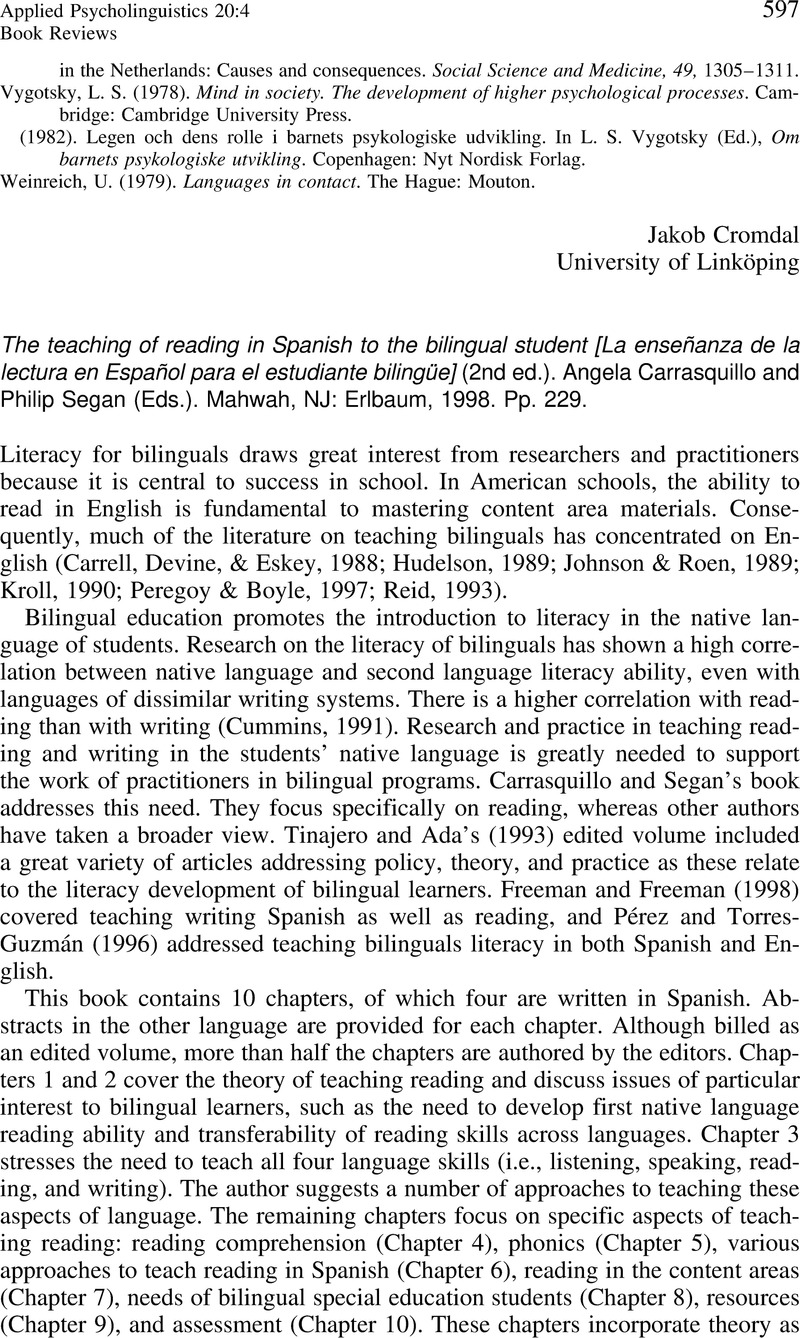No CrossRef data available.
Article contents
The teaching of reading in Spanish to the bilingual student [La enseñanza de la lectura en Español para el estudiante bilingüe] (2nd ed.). Angela Carrasquillo and Philip Segan (Eds.). Mahwah, NJ: Erlbaum, 1998. Pp. 229.
Review products
The teaching of reading in Spanish to the bilingual student [La enseñanza de la lectura en Español para el estudiante bilingüe] (2nd ed.). Angela Carrasquillo and Philip Segan (Eds.). Mahwah, NJ: Erlbaum, 1998. Pp. 229.
Published online by Cambridge University Press: 01 December 1999
Abstract
An abstract is not available for this content so a preview has been provided. Please use the Get access link above for information on how to access this content.

- Type
- Book Reviews
- Information
- Copyright
- Copyright © Cambridge University Press 1999
References
Carrell, P., Devine, J., Eskey, D. (Eds.). (1988). Interactive approaches to second language reading. New York: Cambridge University Press.Google Scholar
Cummins, J. (1991). Interdependence of first- and second-language proficiency in bilingual children. In Bialystok, E. (Ed.), Language processing in bilingual children (pp. 70–89). New York: Cambridge University Press.Google Scholar
Freeman, Y. S., & Freeman, D. E. (1998). La enseñanza de la lectura y la escritura en español en el aula bilingüe (Serra Marisela, B., Trans.). Portsmouth, NH: Heinemann.Google Scholar
Hakuta, K, & D’Andrea, D. (1992). Some properties of bilingual maintenance and loss in Mexican background high-school students. Applied Linguistics, 13, 72–99.Google Scholar
Heath, S. B. (1983). Ways with words: Language, life and work in communities and classrooms. Cambridge: Cambridge University Press.Google Scholar
Hudelson, S. (1989). Write on: Children writing in ESL. Englewood Cliffs, NJ: Prentice-Hall Regents.Google Scholar
Jimenez, R. T., García, G. E., & Pearson, P. D. (1995). Three children, two languages, and strategic reading: Case studies in bilingual/monolingual reading. American Educational Research Journal, 32, 67–97.Google Scholar
Johnson, D. M., & Roen, D. H. (1989). Richness in writing: Empowering ESL students. New York: Longman.Google Scholar
Kroll, B. (1990). Second language writing: Research insights for the classroom. Cambridge: Cambridge University Press.Google Scholar
Leong, C. K. (1978). Learning to read in English and Chinese: Some psycholinguistic and cognitive considerations. In Feitelson, D. (Ed.), Cross-cultural perspectives on reading and reading research (pp. 157–173). Newark, DE: International Reading Association.Google Scholar
Peregoy, S. F., & Boyle, O. F. (1997). Reading, writing and learning in ESL. New York: Addison- Wesley Longman.Google Scholar
Pérez, B. (Ed.). (1998). Sociocultural contexts of language and literacy. Mahwah, NJ: Erlbaum.Google Scholar
Pérez, B., & Torres-Guzmán, M. E. (1996). Learning in two worlds: An integrated Spanish/English biliteracy approach (2nd ed.). New York: Longman.Google Scholar
Reid, J. M. (1993). Teaching ESL writing. Englewood Cliffs, NJ: Regents/Prentice-Hall.Google Scholar
Saravia-Shore, M., & Arvizu, S. (Eds.). (1992). Cross-cultural literacy: Ethnographies of communication in multiethnic classrooms. New York: Garland.Google Scholar
Tinajero, J. V., & Ada, A. F. (Eds.). (1993). The power of two languages: Literacy and biliteracy for Spanish-speaking students. New York: Macmillan/McGraw-Hill School Publishing.Google Scholar
Waggoner, D. (1993). The growth of multilingualism and the need for bilingual education: What do we know so far? Bilingual Research Journal, 17, 1–12.Google Scholar




